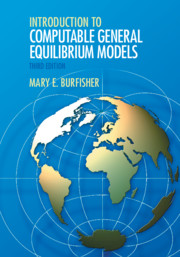Book contents
- Introduction to Computable General Equilibrium Models
- Introduction to Computable General Equilibrium Models
- Copyright page
- Dedication
- Contents
- Figures
- Tables
- Text Boxes
- Acknowledgments
- About This Book
- 1 Introduction to Computable General Equilibrium Models
- 2 Elements of a Computable General Equilibrium Model
- 3 The CGE Model Database
- 4 Final Demand in a CGE Model
- 5 Supply in a CGE Model
- 6 Factors of Production in a CGE Model
- 7 Trade in a CGE Model
- 8 Taxes in a CGE Model
- 9 Regulations in a CGE Model
- 10 Conclusion
- Model Exercises
- Practice and Review Answer Key
- Model Exercise Answer Key
- Book part
- Glossary
- References
- Author Index
- Subject Index
3 - The CGE Model Database
Published online by Cambridge University Press: 11 December 2020
- Introduction to Computable General Equilibrium Models
- Introduction to Computable General Equilibrium Models
- Copyright page
- Dedication
- Contents
- Figures
- Tables
- Text Boxes
- Acknowledgments
- About This Book
- 1 Introduction to Computable General Equilibrium Models
- 2 Elements of a Computable General Equilibrium Model
- 3 The CGE Model Database
- 4 Final Demand in a CGE Model
- 5 Supply in a CGE Model
- 6 Factors of Production in a CGE Model
- 7 Trade in a CGE Model
- 8 Taxes in a CGE Model
- 9 Regulations in a CGE Model
- 10 Conclusion
- Model Exercises
- Practice and Review Answer Key
- Model Exercise Answer Key
- Book part
- Glossary
- References
- Author Index
- Subject Index
Summary
In this chapter, we describe the two components of the database of a computable general equilibrium (CGE) model. The first is the Social Accounting Matrix (SAM). The SAM database reports the value of all transactions in an economy during a period of time. The data are organized in a logical framework that provides a visual display of the transactions as a circular flow of national income and spending. The SAM’s microeconomic data describe transactions made by each agent in a region’s economy. When aggregated, the SAM’s micro data describe the region’s macro economy. The SAM’s micro data can be used to calculate descriptive statistics on an economy’s structure. We describe three extensions to a SAM: non-diagonal make matrices, domestic trade margins, and multi-region input-output tables. A CGE model database also includes elasticity parameters that describe the responsiveness of producers and consumers to changes in income and relative prices. The role of these parameters in driving model results can be evaluated in a sensitivity analysis.
Keywords
- Type
- Chapter
- Information
- Introduction to Computable General Equilibrium Models , pp. 66 - 107Publisher: Cambridge University PressPrint publication year: 2021

